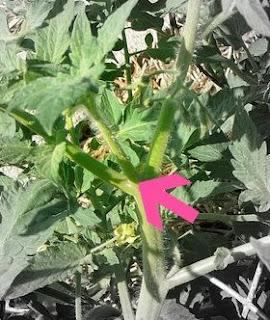 |
| Sucker is a point of arrow Leaf stem is to left of sucker Main stem is to right of sucker |
I am a sometimes sucker pincher. Sometimes I pinch them. Sometimes I don’t. Every year I vow to pinch them, but usually I pinch them early in the season and forget about weekly followup.
You’re reading something that indicates Tomato Patch in the headline, so you know suckers must have something to do with tomato plants. But just what are they?
Here’s how the chapter on vegetables in the University of Maryland Master Gardener Handbook defines them and why you may want to pinch them: “Suckers are shoots that arise from axils (the angle where a plant stem and leaf branch meet). These shoots will eventually produce flowers and fruit. However, moderate pruning will increase fruit size, hasten ripening, and keep your plants more manageable. Prune staked tomatoes to one to three main stems (plant spacing can be reduced in these situations). Remove all other suckers weekly. It is especially important to remove suckers that emerge from the plant base. Pinch shoots off with your fingers.”
 |
| Brandywine Red plant before pruning |
If you read 10 articles on suckers, you probably will get basically similar information but differing details. Here are several differences and my take:
Suckering is important on indeterminate tomato varieties—the “tall” plants that continue growing until frost kills them. By definition, determinate, or “short,” varieties are limited in their growth, have few suckers, and will not leave you groping for sunlight in an overgrown jungle of tomato leaves.
 |
| Brandywine Red plant after pruning |
Some sources emphasize pinching of lower suckers because they usually are shaded by higher leaves and usually produce little fruit. Another reason is that leaves closer to the ground are at higher risk of diseases that are endemic in local soils that can splash onto lower stems during rain or watering if plants aren’t well mulched.
How many suckers should you pinch from each plant? Intensive growing systems, such as Mel Bartholomew’s “Square Foot Gardening,” recommend that you remove all suckers. For general gardening situations, the consensus seems to be to let one or two suckers grow, so each becomes a leader with leaves, flowers, and fruit of its own.
This year I’ve vowed once again to pinch suckers weekly. I started Friday, perhaps two weeks behind schedule. Some of the suckers already were a foot long, and when I pinched them, sometimes they pulled small strips of tissue from the main stems. That’s a good reason and also a reminder to pinch suckers when they are young and tender.
Photo 1 shows a sucker growing in the axil where tomato stem and leaf join. Photo 2 shows one of my Brandywine Red plants before I pinched suckers. Photo 3 shows the same Brandywine Red after I removed all the extra growth. The difference is remarkable—sort of like when I get a haircut after four or five weeks.
Since I was doing “catch-up pinching,” it took nearly an hour and I carried an armload of pinched suckers from my Tomato Patch. But if I pinch regularly, future maintenance will be both quick and minimal.
Should you pinch your suckers? I like the way John Page puts it in the little booklet “Grow the Best Tomatoes” (Storey Publishing): “Prune them if you are a sucker-pruner. Pinch them if you are a sucker-pincher. Let them go and things will get pretty dense and green, often requiring some topping.”
Here are two short videos that will show you how to pinch suckers. To watch Jon Traunfeld of the University of Maryland Extension in “Pruning Tomato Suckers” (3:17 minutes), CLICK HERE.
To watch Johnny’s Selected Seed video, “How to Prune Tomatoes (2:52 minutes), CLICK HERE.
I spent a half hour this morning (June 26)removing new suckers that had grown since I first pinched them on June 20. Some were quite large, indicating I really should check them every 5 to 7 days. And this second pinching reminded me that it's good to take an "overall" look at times, so I can spot the suckers I missed when checking closely. There always are some! Pinch those suckers!
ReplyDeleteThis is very good, like your tips and insights a lot.
ReplyDelete